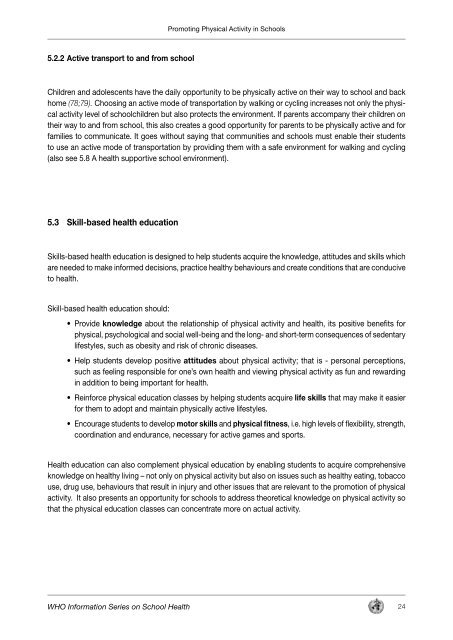WHO INFORMATION SERIES ON SCHOOL HEALTH ... - PAHO/WHO
WHO INFORMATION SERIES ON SCHOOL HEALTH ... - PAHO/WHO
WHO INFORMATION SERIES ON SCHOOL HEALTH ... - PAHO/WHO
You also want an ePaper? Increase the reach of your titles
YUMPU automatically turns print PDFs into web optimized ePapers that Google loves.
5.2.2 Active transport to and from school<br />
Promoting Physical Activity in Schools<br />
Children and adolescents have the daily opportunity to be physically active on their way to school and back<br />
home (78;79). Choosing an active mode of transportation by walking or cycling increases not only the physical<br />
activity level of schoolchildren but also protects the environment. If parents accompany their children on<br />
their way to and from school, this also creates a good opportunity for parents to be physically active and for<br />
families to communicate. It goes without saying that communities and schools must enable their students<br />
to use an active mode of transportation by providing them with a safe environment for walking and cycling<br />
(also see 5.8 A health supportive school environment).<br />
5.3 Skill-based health education<br />
Skills-based health education is designed to help students acquire the knowledge, attitudes and skills which<br />
are needed to make informed decisions, practice healthy behaviours and create conditions that are conducive<br />
to health.<br />
Skill-based health education should:<br />
• Provide knowledge about the relationship of physical activity and health, its positive benefits for<br />
physical, psychological and social well-being and the long- and short-term consequences of sedentary<br />
lifestyles, such as obesity and risk of chronic diseases.<br />
• Help students develop positive attitudes about physical activity; that is - personal perceptions,<br />
such as feeling responsible for one’s own health and viewing physical activity as fun and rewarding<br />
in addition to being important for health.<br />
• Reinforce physical education classes by helping students acquire life skills that may make it easier<br />
for them to adopt and maintain physically active lifestyles.<br />
• Encourage students to develop motor skills and physical fitness, i.e. high levels of flexibility, strength,<br />
coordination and endurance, necessary for active games and sports.<br />
Health education can also complement physical education by enabling students to acquire comprehensive<br />
knowledge on healthy living – not only on physical activity but also on issues such as healthy eating, tobacco<br />
use, drug use, behaviours that result in injury and other issues that are relevant to the promotion of physical<br />
activity. It also presents an opportunity for schools to address theoretical knowledge on physical activity so<br />
that the physical education classes can concentrate more on actual activity.<br />
<strong>WHO</strong> Information Series on School Health 24

















